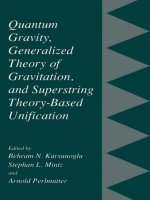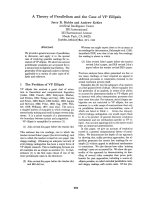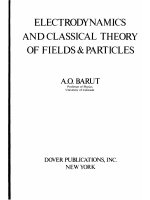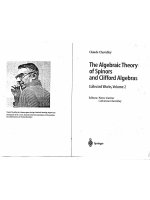Theory of correspondences and games
Bạn đang xem bản rút gọn của tài liệu. Xem và tải ngay bản đầy đủ của tài liệu tại đây (2.06 MB, 151 trang )
THEORY OF CORRESPONDENCES AND
GAMES
HE, WEI
(B.S., Peking University)
A THESIS SUBMITTED
FOR THE DEGREE OF DOCTOR OF PHILOSOPHY
DEPARTMENT OF MATHEMATICS
NATI O N AL UNIVERSITY OF SINGAPORE
2014
ii
iii
Declaration
Iherebydeclarethatthethesisismyoriginalworkandithasbeenwrittenbyme
in its entirety. I have duly acknowledged all the sources of information whi ch have been
used in the thesis.
This thesis has also not been submitted for any degree in any university previousl y.
He, Wei
July 28, 2014
iv
Acknowledgement
I would like to express my sincere appreciation to my supervi sor Prof. Sun Yeneng. For
me, he is not only the greatest supervisor who always prepares to listen to my naive
ideas, answers my questions, encourages me to explore various new areas, but also a
perfect friend wh o would like to sha r e his thinking about the way of life. Without
his continuous guidance, encouragement and help, what I have achieved would not be
possible.
I would li ke to take this o p portunity to thank Prof. Chen Yi-Chun, Prof. Luo Xiao ,
Prof. Satoru Takahashi and Prof. Nicholas Yannelis for their encouragement and help
during these years. Discussions with them significantly broadens my horizon, deepens
my understanding and shapes my views in the field of Game Theory. I have also benefited
and learnt a lot from my research family: Prof. Yu Haomiao, Prof. Zhang Yongchao,
Prof. Sun Xiang, Mr. Qiao Lei a n d Ms. Zeng Yishu. Special thanks must be given
to Prof. Nicholas Yannelis and Sun Xiang, who gave valuable advice on my research
projects.
I am also grateful to my postgraduate friends in NUS, including but not lim i t ed to,
Jia Xiaowei, Li Shangru, Sun Yifei, Wang Haitao, Zh an g Rong, Zhou Feng, for their
help, friendship and the good time we have together.
Finally, my deepest appreciation and thanks are due to my family for their uncondi-
tional love and whole hearted support. In particular, I am greatly indebted to my wife
Zhao Yang for her constant love, understanding, support and encouragement, which are
great source of strength throughout the years of my PhD study.
He, Wei
July 22, 2014
v
vi ACKNOWLEDGEMENT
Contents
Acknowledgement v
Contents ix
Summary xi
1 Introduction 1
1.1 Modeling Infinitely Many Agents 2
1.2 Conditional Distributions/Expectations of Correspondences 3
1.3 Games with Incomplete Information 5
1.4 Discounted Stochastic Games 6
1.5 Organization 6
2 Modeling Infinitely Many Agents 9
2.1 Introduction 9
2.2 Characterizations of the Agent Space 12
2.2.1 Setwise Coarseness 12
2.2.2 Applications 14
2.3 Unification 16
2.3.1 Distributional Equilibria 16
2.3.2 Standard Representation 18
vii
viii CONTENTS
2.3.3 Hyperfinite Agent Space 19
2.3.4 Saturated Agent S p a ce 20
2.3.5 Many More Players than Strategies 22
2.4 Necessity 22
2.5 Proofs 23
2.5.1 Proofs of Results in Section 2.2 23
2.5.2 Proof of Theorem 1 26
2.5.3 Proofs of Theorem 2 and Proposition 4 31
3 Theory of Correspondences 39
3.1 Introduction 39
3.2 Preliminary 42
3.3 Regular Conditional Distributions of Correspondences 43
3.3.1 Distributions of Correspondences 43
3.3.2 Converse Results for Distributions of Correspondences 46
3.3.3 Regular Conditional Distribu t i on s of Correspondences 51
3.4 Conditional Expect at i o n s of Banach Valued Correspondences 57
3.4.1 Basic Definitions 57
3.4.2 Regularity Properties 59
3.4.3 Converse Results 70
3.5 Conditional Expectations of Correspondences in R
n
74
3.5.1 Basic Definitions 74
3.5.2 Regularity Properties 75
3.5.3 Proofs 76
4 Games with Incomplete Information 83
4.1 Introduction 83
CONTENTS ix
4.2 Games with Incomplete Information and General Action Spaces 85
4.2.1 Relative Di↵useness of Information 87
4.2.2 Existence of Pure Strategy Equilibria 88
4.2.3 Undistinguishable Purification 91
4.2.4 Concluding Remarks 97
4.3 Bayesian Games with Inter-player Information and Finite Actions 98
4.3.1 Model 98
4.3.2 Existence of Pure Strategy Equilibria 99
4.3.3 Purification 100
4.3.4 Proofs 101
5 Stochastic Games 111
5.1 Introduction 111
5.2 Discounted Stochastic Games 113
5.3 Main Results 115
5.3.1 Stochastic Games with Coarser Transition Kernels 115
5.3.2 Stochastic Games with Decomp o sa b l e Coarser Transition Kernels 117
5.3.3 Decomposable Coarser Transition Kernels on the Atomless Part . 119
5.3.4 Minimality of t h e Condition 121
5.4 Discussion 123
5.5 Concluding Remarks 127
Bibliography 131
x CONTENTS
Summary
In this thesis, we will consider games with large structures in the sense that the play-
er/state space can be uncountable. We first propose a condition called ”setwise coarse-
ness” and prove several regularity properties (convexity, compactness and preservation
of upper hemicontinuity) of conditional distributions/expectations of correspondences in
various contexts as our mathematical preparation s. Based on this condition, new results
on l a r ge games/economies, Bayesian games and stochastic games are presented.
The classical Lebesgue unit interval is widely used to model a continuum of agents.
However, it has been pointed out that the Lebesgue unit interval does not h ave a number
of d e si r ab l e properties in various situations as an agent space, and di↵erent approaches
have been proposed to resolve those problems. In Chapter 2,wewillseparatetheconcept
of an agent space with the concept of the characteristics type space which is generated by
the mapping of agents’ characteristics. The “setwise coarseness” condition is prop osed,
which requires that the agent space is str ict l y richer than the characteristics type space
on any nontrivial collection of agents. We will show that this condition is more general
than all the special approaches mentioned above, and it can be used to handle the failure
of the Lebesgue unit i nterval. More importantly, the optimality of the setwise coarseness
condition will be illustrated by showing it s necessity in deriving certain results i n general
equilibrium theory and game t heor y.
The theory of correspondences has important applications in a variety of areas. How-
ever, basic regulari ty properties on the distr i b u t ion s of correspondences/integrals of
Banach valued correspondences such as convexity, closeness, compactness and preser-
vation of upper hemicontinuity may all fail when the u n d er l yi n g probability space is
the Lebesgue unit interval. In Chapter 3, we sh ow that all these properties could be
retained ba sed on the setwise coarseness condi t i o n . If the range of the correspondence
is the Euclidean space R
n
,wecanfurtherextendthestandardresultsonintegralsof
correspondences t o the conditional expectat i ons of correspondences. In addition, we not
xi
xii SUMMARY
only generalize the classical results on distributions/i ntegrals of correspondences to the
case of conditional distributions/expectations, but also demonst r at e the necessity of the
relevant condition.
Since Harsanyi (1967–68), games with incomplete information have been widely s-
tudied and found applications in many fields. If players’ information is di↵use, positive
results have been obtained when all players’ action spaces are finite and the information
structure is disparate. In Chapter 4,weextendthisresulttotwodirectionsandob-
tain the existence of pure strategy equilibria in the following frameworks: (1) Bayesian
games with general action spaces; and (2) Bayesian games with interdependent payo↵s
and correlated types.
Beginning with Shapley (1953), the existence of stationary Markov perfect equilibria
in discounted stochastic games has remained an important problem. However, no general
existence result, except for several special classes, has been obtained in the liter at u r e so
far. The main result in Chapter 5 is to show the existence of stationary Markov perfect
equilibria in stochastic games under a general condition called “(decomposable) coarser
transition kernels” by establishing a n ew connection between the equilibrium payo↵
correspondences in stochastic games and a general result on the conditional expectations
of correspondences. The proof is remarkably simple and our theorems cover various
previous existence results. The minimality of our condition is also illustrated from a
technical point of view.
Chapter 1
Introduction
Games with large structures can arise in many situations.
1
For example, to describ e
the competitive market in which the influence of every particular participant becomes
negligible, one needs to model the interaction of many agents. New phenomena can be
discovered in large games/economies while they may not necessarily occur in the case of
a fixed finite number of agents. A well-known example is the Edgeworth conjecture th a t
the set of core allocations tends to coincide with the set of competitive equilibria as the
number of agents goes to infinity , while the latter set is in general strictly smaller than
the former one if one only focuses on a finite economy (see Debreu and Scarf (1963)).
2
Another example is Bayesian games, in which if information is assumed to be suffi-
ciently disp arat e among players and its distribution is sufficiently di↵use, then random-
ization, which has limited appeal in many practical situations, can be eliminated and
players might restrict their attention to pure strategies.
3
In addition, equili br i u m exis-
tence and characterization results of discounted stochastic games is a very active area
of research. Recently, due to the increasing usefulness of sto chastic games in modeling
economic situ ati on s, much attention has been given to it in the setting with uncountable
states.
4
While the existence of equilibrium is usually easy to obtain in finite games, the prob-
lem is in general significantly harder when one considers games with large structures.
1
For “games with large structure”, we mean that some components (pl ayers, actions, states) of the
game can be very large (may be u nc ountable).
2
For more discussion of mass phenomena in economics, see Khan and Sun (2002).
3
See, for example, Milgrom and Weber (1985), Radner and Rosenthal (1982) and Khan, Rath and
Sun (2006).
4
See Duffie et al. (1994), Duggan (2012) and Levy (2013) among others.
1
2 Chapter 1. Intro duct io n
To prove the equilibrium existence, one usually works with an equilibrium-related cor-
respondence. If the regularity properties (convexity, compactness and preservation of
upper hemicontinuity) of the correspondence can be established, then the standard fixed
point method is appli ca b l e. However, these regularity properties could fail if the game
under consideration has a large structure, and the equilibrium existence is then prob-
lematic. As a result, n e w mathematical results on the theory of co r respondences must
be proved first as the foundation to adopt the fixed point method.
In this thesis, we will consider various games with large structures. We shall first pro-
pose an appropriate condition called “setwise coarseness” and prove regularity properties
of the conditional distributions/expectations of correspondences in various contexts as
our mathematical preparations. Based on this condition, new existence results in large
games/economies, Bayesian games an d stochastic games are presented.
1.1 Modeling Infinitely Many Agents
In a vast literature of economics, one needs to model th e interaction of many agents i n
order to discover mass phenomena that do not necessarily o ccur in the case of a fixed
finite number of agents. As pointed out by von Neumann and Morgenstern (1953),
When the number of participants becomes really great, som e hope emerges
that the influence of every particular participant will become negligible, and
that the above difficulties may recede and a more conventional theory become
possible. Indeed, this was the starting point of much of what is best in
economic theory.
The classical Lebesgue unit interval is usual ly used to avoid complicated combinatori al
arguments that may involve multiple steps of approximations for a large but finite num-
ber of agents.
5
As a result, a general a t om l e ss measure space of a gents is often referred
to as a continuum of agents .
However, it has b een pointed out that the Lebesgue unit interval does not have a
number of desirable properties in various situations as an agent space. F or example, (1)
large economies may not have the determinateness property in the sense that economies
5
For some classical references, see, for example, Milnor and Shapley (1961), Aumann (1964), Hilden-
brand (1974) and Hammond (1979).
1.2. Conditional Distributions/Expectations of Correspondences 3
with the same distr ib u t i on on agents’ characteristics may not have the same set of distri-
butions of Walras allocations; (2) pure-strategy Nash equil i b r i a may not exist in a large
game with uncountably many actions. To resolve those problems, di↵erent approaches
have been proposed, such as distributional equilibria, standard representations, hyperfi-
nite agent spaces, saturat ed probability spaces, and agents spaces wit h the condition of
“many more agents than strategies”.
6
In Chapters 2, we will separate the concept of an agent space with the concept of
the characteristics type space which is ge n er at ed by the mapping of agents’ character-
istics. The “setwise coarseness” condition is proposed, which requires that the agent
space is strictly richer than the characteristics type space on any nontrivial collection of
agents. We will show that this condition is more general than all the special approaches
mentioned in the end of the last paragraph. We will also show that it can be used to
handle the failure of the Lebesgue unit interval. In addition, the optimality of the set-
wise coarseness condition will be illustrated by showing its necessity in deriving certain
results in general equilibrium theory and game theory.
1.2 Conditional Distributions/Expectations of Cor-
respondences
The theory of correspondences, which has important applications in a variety of areas
(including optimization, control theory and mathematical economics), has been stud-
ied extensively in recent years. However, basic regularity properties on the distribu-
tions of correspondences/integrals of Banach valued correspondences such as convexity,
closeness, compactness and preservation of upper hemicontinuity may all fail when the
underlying probability space is the Lebesgue unit interval.
7
To resolve these issues, various conditions have been proposed.
8
In particular, Sun
(1996, 1997) considered a class of ri ch measure spa ces, the so-called Loeb measure s-
paces constructed from the method of nonstandard analysis. Keisler and Sun (2009)
then showed that the abstract property of saturation on a probability space is not only
6
See Mas-Colell (1984), Hart , Hildenbrand and Koh lberg (1974), Khan and Sun (1999), Keisler and
Sun (2009)andRustichini and Yannelis (1991).
7
See Sun (1996, 1997) and Keisler and Sun (2009) for examples.
8
For some recent development, see for example, Sun (1996, 1997), Sun and Yannelis (2008), Podczeck
(2008), Keisler and Sun (2009) and Khan and Zhang (2012).
4 Chapter 1. Intro duct io n
sufficient but also necessary for any of these regularity properties for distributions of cor-
respondences to hold. Furthermore, Sun and Yannelis (2008)foundthatalltheexisting
results for Bochner/Gel
0
fand integrals of Banach valued correspondences in Loeb spaces
can be easily transferred to results on saturated spaces vi a the saturation property, and
Podczeck (2008)provedtheconvexityandcompactnessresultsovergeneralsaturated
probability spaces without appealing to the existing relevant results o n Loeb spaces.
To be precise, consider a correspondence F from an atomless probability space
(T, T ,)tothePolishspaceX.LetR
(T ,G)
F
be the set of all µ
f|G
such that f is a
measurable selection of F ,whereµ
f|G
is the regularly conditional distribution induced
by f given some sub--algebra G of T .IfG is the trivial -algebra, then R
(T ,G)
F
is re-
duced to be D
(T ,G)
F
,thesetofdistributionofthecorrespondenceF .Similarly,onecan
define the integral/conditional expectation of a correspondence.
In application s, one often encounters measure spaces that are countably generated,
while a saturated probability space is necessarily rich in the sense that any of its non-
trivial sub-measure space is not countably generated module null sets. To reco n ci l e th i s
possibility of non-absolute richness, we will study the regularity properties relying on
the condition of “setwise coarseness”, which means that T does not coincide with G
when they are restricted on any non-trivial set in T .
Restricting the correspondence F to be G-measurable and assuming that G is setwise
coarser than T ,weareabletoshowthat(1)thesetwisecoarsenessconditionisboth
necessary and sufficient for all the regularity properties on the distributions of corre-
spondences; (2) these regularity properties can be extended to regular conditional dis-
tributions of correspondences; (3) the sufficiency and necessity of the setwise coarseness
condition can be also demonstrated for the regularity properties of the Bochner/Gel
0
fand
integrals and conditional expectations of Banach valued correspondences. Furthermore,
if the range of the correspondence F is the Euclidean space R
n
,thenwecanallowthe
correspondence F to be T -measurable, hence extend the standard results on integrals
of correspondences.
Therefore, we not only generalize the classical result s on distributions/integrals of
correspondences to the case of condi t i onal distributions/expectations, but also demon -
strate the necessity of the relevant condition.
1.3. Games w it h I nco mpl et e Information 5
1.3 Games with Incomplete Information
Since Harsanyi (1967–68), games with incomplete information have been widely studied
and found applications in many fields. Various kinds of hypotheses are proposed on
the formulation of such games to guarantee the existence of pure strategy equilibria. In
particular, if players’ information i s di↵use, posi t i ve results have been obtained when all
players’ action spaces are finite and the information structure is disparate; see Radner
and Rosenthal (1982), Milgrom and Weber (1985)andKhan, Rath and Su n (2006).
These results lead to natural conjectures in two directions: can one obtain the existence
of pure strategy equilibria in the following frameworks: (1) Bayesian games with general
action spaces; and (2) Bayesian games with interdependent payo↵ and correlated types?
To resolve the first problem, the purifi ca t i on m et h od is adopted as the main tool
on Loeb/saturated probability spaces; see Loeb and Sun (2006)andWang and Zhang
(2012). Nevertheless, these results rely on the condition that th e probability spaces are
saturated, and hence cannot contain any countably-generated part. Since the widely
used information spaces are usually Polish spaces, the assumption of saturated proba-
bility spaces will be violated in various applications. In Chapter 4,weshalldistinguish
di↵erent roles of the di↵useness of information and describe the strategy-relevant and
payo↵-relevant di↵useness of information separately. The relation between these two
kinds of di↵useness is characterized by the “relative di↵useness” assumption, which
basically says that the strategy-relevant di↵useness is essentially richer than the payo↵-
relevant di↵useness on any nonnegligible information subset. Based on this assumption,
we are able to prove the existence of pure strategy equilibria in games with general ac-
tion spaces without invoking any existence result of behavioral/distributional strategy
equilibria.
For the second problem, there is a substantial literature on the equilibrium existence
results of Bayesian games with finite actions; see, for example, Radner and Rosenthal
(1982), Milgrom and Weber (1985), Khan, Rath and Sun (2006)andBarelli and Duggan
(2013). In Chapter 4,weformulatethenotionof“inter-playerinformation”todescribe
the influence of player i’s private information in oth e r players’ payo↵s. The condition
of “coarser inter-player information” is proposed and we show that this condition is not
only sufficient but also necessary for the existence of pure strategy equilibrium, while
interdependent payo↵s and correlated types are allowed in our setting. In particular,
the purification results will be presented for both problems.
6 Chapter 1. Intro duct io n
1.4 Discounted Stochastic Games
Beginning with Shapley (1953), the existence of stationary Markov perfect equilibria in
discounted stochastic games has remained an important problem. Given that stochastic
games with general state spaces have found applications in various areas of economics,
the issue on the existence of an equilibrium in stationary strategies for such games has
received consi d er a b l e attention in the last two decades; see Nowak and Raghavan (1992),
Duffie et al. (1994), Duggan (2012)andLevy (2013). However, no general existence
result, except for several special classes, has been obtained in the literature so far.
Our main purpose is to show the existence of stationary Markov perfect equilibria in
stochastic games under a general condition called “(decomposable) coarser transition k-
ernels” by establishing a new connection between the equilibrium payo↵ correspondences
in stochastic games and a general result on the conditional expectations of correspon-
dences. The proof is remarkably simple and our theorems cover previous existence
results for sto chastic games considered in Nowak a n d Raghavan (1992), Duffie et al.
(1994), Nowak (2003)andDuggan (2012), while no product structure is imposed on the
state space. We also il l u st r ate the minimality of our gen er al condition from a technical
point of view.
1.5 Organization
The main results in Chapters 2, 3, 4 and 5 are based on the papers He, Sun and Sun
(2013), He and Sun (2014) and He and S un (2013a,b,c,d).
This thesis is organized as follows. In Chapter 2,weproposeaconditioncalled
“setwise coarseness” and illustrate its usefulness in large games and economies. Chap-
ter 3 establishes regularity properties (convexity, compactness and preservation of upper
hemicontinuity) of conditional distributions/expectations of correspondences, which will
serve as our m at h em a t i ca l tools to p r ove the equilibrium existence result s. In Chapter 4,
we study games with incomplete information and show the existence of pure-strategy e-
quilibria in various settings. In Chapter 5,wepresenttheexistenceofstationaryMarkov
perfect equilibria in discounted stochastic games.
1.5. Organiza ti on 7
8 Chapter 1. Intro duct io n
Chapter 2
Modeling Infinitely Many Agents
2.1 Introduction
Every economic model involves economic agents. Wh en a model considers a fixed finite
number of agents, the most natural agent space is the set {1, 2, ,n} for some positive
integer n. In a vast literature in economics, one also needs to model the interaction
of many agents in order to discover mass phenomena that do not necessarily occur in
the case of a fixed finite number of agents. A well-known example is the Edgeworth
conjecture that the set of core allocations will shrink to the set of competitive equilibria
as the number of agents goes to infinity though the former set is in general strictly bigger
than the latter set for an economy with a fixed finite number of agents.
1
To avoid complicated combinatorial arguments that may involve multiple steps of
approximations for a large but finite number of agents, it is natural to consider economic
models with an infinite number of agents. The mathematical abstraction of a n atomless
(countably-addit i ve) measure space of agents provides a co nvenient idealization for a
large but finite number of agents. The archetype space in such a setting is the classical
Lebesgue unit interval.
2
That is why a general atomless measure space of agents is often
referred to as a continuum of agents in a large literature in economics.
3
1
See, for example, D eb re u and Scarf (1963), Hildenbrand (1974)andAnderson (1978) . Here are a
few recent references on related models with large but finite number of agents, McLean and Postlewaite
(2002, 2004), Serrano, Vohra and Volij (2001), Xiong and Zheng (2007).
2
For some classical references, see, for example, Milnor and Shapley (1961), Aumann (1964), Hilden-
brand (1974) and Hammond (1979).
3
Economic models with a continuum of agents have continued to be widely used in various fields of
economics. For some recent references, see, for example, Azevedo, Weyl and White (2013) and Hara
9
10 Chapter 2. Modeling Infinitely Many Ag ents
However, it has als o been found that the Lebesgue unit interva l does not have a num-
ber of desirable p r operties in various situations as a n agent space. First, it is pointed o u t
in general equilibrium theory that large economies may not have the determinateness
property; namely, large economies with the same distribution on agents’ characteristics
may not have the same set of distribu t i on s of Walras allocations. Second, pure-st r at eg y
Nash equ i l i br i a may not exist in a l a rg e game with uncou ntably many actions. Third,
dissonance has also been found between a large game and its discretized versions. In ad -
dition, from a mathematical point of view, some regularity properties (such as convexity,
compactness, purification, and upper-semicontinuity) of the distribution of correspon-
dences and of the integration of corresp ondences in an infinite-dimensional setting fail
to hold when the underlying measure space is the Leb esgue unit interval. To resolve
those problems, di↵erent approaches have been proposed, such as distributional equi-
libria, standard representations, hyperfinite agent spaces, saturated probability spaces,
and agents spaces with the condition of “many more agents than strategies”.
4
Abasicandnaturalquestionarises: whichmeasurespacesaremostsuitablefor
modeling many economic agents? A key point in this paper is to separate the concept
of an agent space with the concept of the characteristics type space which is generated
by the mapping of agents’ characteristics. The “setwise coarseness” condition proposed
here requires that the agent space is strictly richer than the characteristics type space
on any nontrivial collection of agents. We will show that this condition is more general
than all the specia l approaches mentioned in the end of the last paragraph. We will also
show that it can be used to handle the failure of the Lebesgue unit interval as discussed
above.
More importantly, we illustrate the opti m al ity of the setwise coarseness cond i t i on by
showing its necessity in derivi n g certain result s in general equilibrium th eo r y and game
theory. The first question we consider is the determinateness of general equilibrium in
large economie s. As pointed out in Kannai (1970,p.811),G´erardDebreuremarkedthat
there exists a serious difficulty with larg e econ om i e s in the sense that large econom i es
with the same distribution on agents’ characteristics do not have the same set of distribu-
tions for the core allocations ( i.e.,Walrasallocations);Kannai (1970, p. 811) presented
a concrete example illustrating this point. It was then conjectured by Robert Aumann
(2005) in general equilibrium theory, Mailath, Postlewaite and Samuelson (2013), Yannelis (2009), Yu
(2014) and Sun and Zhang (2014) in game theory, Duffie, Gˆarleanu and Pedersen (2005) and Duffie and
Strulovici (2012) in finance.
4
Detailed di s cu ssi on s and reference s about problems wit h the Lebesgue uni t interval and di↵erent
approaches for handling them will be given in Section 2.3 below.
2.1. Introduction 11
that the closure of the sets of distributions for the core allocations are th e same for
large economies with the same distribution on agents’ characteristics; see Kannai (1970,
p. 813). That conjecture was resolved in Hart, Hildenbrand and Kohlberg (1974). To
show that the distribution of agents’ characteristi cs is a conci s e and accurate description
of a large economy, Hart, Hildenbrand and Kohlberg (1974)usedtheapproachofstan-
dard representations to obtain exact equivalence instead of “same closu r e” in Aumann’s
conjecture. As shown in Proposition 2 below, it is easy to see that our setwise coarseness
condition is sufficient for such a result. The surprising point is that our condition is also
necessary for the exact determinateness property (see Theorem 1 below).
In terms of optimality for the setwise coarseness condition, the second qu es ti o n we
consider involves games with many agents. Motivat ed by the consideration of social
identities as in Akerlof and Kranton (2000)andBrock and Durlauf (2001), Khan et
al. (2013) introduced a general class of large games in which agents have names and
determinate social-types and/or biological traits. For such large games, they showed the
nonexistence of Nash equilibr i a with the Lebesgue unit interval as an agent space, and
characterized the existence via a saturated agent space. In addition, we note that the
existence of Nash equilibria is also a key issue for the determinat en ess property in large
games. Khan and Sun (1999,p.472)presentedanexampleoftwolargegameswiththe
same distribution on agents’ characteristics where one has a Nash equilibriu m while the
other does not! It implies that the closures of the sets o f distributions for the Nash equi-
libria in these two large games are never equal. Thus, the determinateness property even
fails in an approximate sense in terms of the closures. Khan and Sun (1999)resolvedthe
relevant issues by working with a hyperfinite Loeb counting measure. Our Propositions 3
and 4 show that the existence of Nash equilibria and exact determi n a te n ess property in
large games follow easily from the setwise coarseness condition. The optimality of such
aconditionisdemonstratedinthesensethatitisnecessaryforobtainingeachofthese
two results (Theorem 2 and Proposition 4).
The rest is organized as follows. In S ect i on 2.2,weintroducetheconditionofsetwise
coarseness for agent spaces, and show that it is equivalent to three ot h er conditions. The
setwise coarseness condition is then used to obtain positive results in large economies
and games while the corresponding results fail when the Lebesgue unit interval is used as
an agent space. In Section 2.3,weshowthattheconditionofsetwisecoarsenessismore
general than various approaches proposed to handle the failure of the Lebesgue u n i t
interval. In Section 2.4,weshowthatthesetwisecoarsenessconditionisnecessaryin
12 Chapter 2. Modeling Infinitely Many Ag ents
deriving positive results for large economies and games mentioned in Section 2.2.Some
technical proofs are collected in Section 2.5.ThischapterisbasedonthepaperHe, Sun
and Sun (2013).
2.2 Characterizations of the Agent Space
2.2.1 Setwise Coarseness
A typical economic model starts with an agent space. Each agent is described by some
characteristics, such as strategy/action set, payo↵, preference, endowment/income, in-
formation, social or biological traits and etc.Themappingforthecharacteristicsofall
the agents will generate a sub--algebra on the agent space. Thus it is natural to res tr i ct
our attention to a sub--algebra th at is to be used in modeling agents’ characteristics.
The correspo n d i ng restricted probability sp a ce on such a sub--algebra will be called
the characteristics type space. In this section, we will introduce several conditions on
these two probability spaces and show their equivalence.
Let (⌦, F,P)beanatomlessprobabilityspacewithacompletecountably-additive
probability measure P.
5
Let G be a sub--algebra of F.Theprobabilityspaces(⌦, F,P)
and (⌦, G,P)willbeusedtomodeltheagentspaceandthecharacteristicstypespace
respectively. For any nonnegligible subset D 2F,therestrictedprobabilityspace
(D, G
D
,P
D
)isdefinedasfollows: G
D
is the -algebra {D \ D
0
: D
0
2G}and P
D
the
probability measure re-scaled from the restriction of P to G
D
.Furthermore,(D, F
D
,P
D
)
can be defined similarly.
Let X, Y denote Polish spaces (complete separable metrizable topological spaces),
and M(X)thespaceofallBorelprobabilitymeasuresonX with the weak topology.
We recall that M(X)isagainaPolishspace. Foranyµ 2M(X ⇥ Y ), let µ
X
be the
marginal of µ on X.
Now we are ready to present the following definition.
Definition 1. (1) G is said to be setwise coarser than F if for every D 2Fwith
P (D) > 0, there exists an F-measurable subset D
0
of D such that P (D
0
4D
1
) > 0
for any D
1
2G
D
.
6
5
A probability space (⌦, F,P) (or its -algebra) is atomless if for any nonnegligible subset E 2F,
there is a F-measurable subset E
0
of E such that 0 <P(E
0
) <P(E).
6
This condition was called “nowhere equivalence” in He, Sun and Sun (2013), see also He and Sun
2.2. Characteri za ti ons of the Agent Space 13
(2) F is conditional atomless over G if for every D 2Fwith P (D) > 0, there exists
an F-measurable subset D
0
of D such that on some set of positive probability,
0 <P(D
0
|G) <P(D |G).
(3) F is said to be relatively saturated with respect to G if for any Polish spaces X
and Y , any measure µ 2M(X ⇥ Y ), and any G-measurable mapping f from ⌦ to
X with P f
1
= µ
X
, there exists an F-measurable mapping g from ⌦ to Y such
that µ = P (f,g)
1
.
(4) G admits an atomless independent supplement in F if there exists another sub-
-algebra H of F such that (⌦, H,P) is atomless, and for any C
1
2Gand C
2
2H,
P (C
1
\ C
2
)=P (C
1
)P ( C
2
).
When (⌦, F,P)and(⌦, G,P)modeltherespectivespacesofagentsandcharac-
teristics types. The condition that G is setwise coarser than F implies that for any
nonnegligible set D of agents, F
D
is always essentially richer than G
D
.
7
These f ou r conditions characterize the relation between F and G from di ↵er ent as-
pects, and the following proposition shows that they ar e eq u i valent given that G is
countably generat ed . Note that a probabil i ty space (or its -algebra) is said to be
countably generated if its -algebra can be gen erated by countably many measurable
subsets together with the null sets.
Proposition 1. Let (⌦, F,P) be an atomless probability space, and G a sub--algebra
of F.IfG is countably generated,
8
then the following statements are equivalent.
(i) G is setwise coarser than F.
(ii) F is conditional atomless over G.
(iii) F is relatively saturated with respect to G.
(iv) G admits an atomless independent supplement in F.
(2014).
7
Condition (2) is simply called “F is atomless over G” in Definiti on 4.3 of Hoover and Keisler
(1984). The concept of “relative saturation” refines the concept of “saturation” used in Corollary 4.5(i)
of Hoover and Keisler (1984).
8
The implication “(iii))(iv)” may not b e true without the condition that “G is countably gene rat e d”,
for example, if G is saturated and F = G, the statement (iii) holds while the statement (iv) is certainly
false. Other implications are still true even though G is not countably generated.









